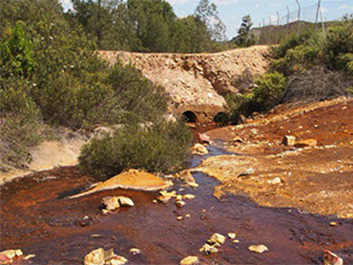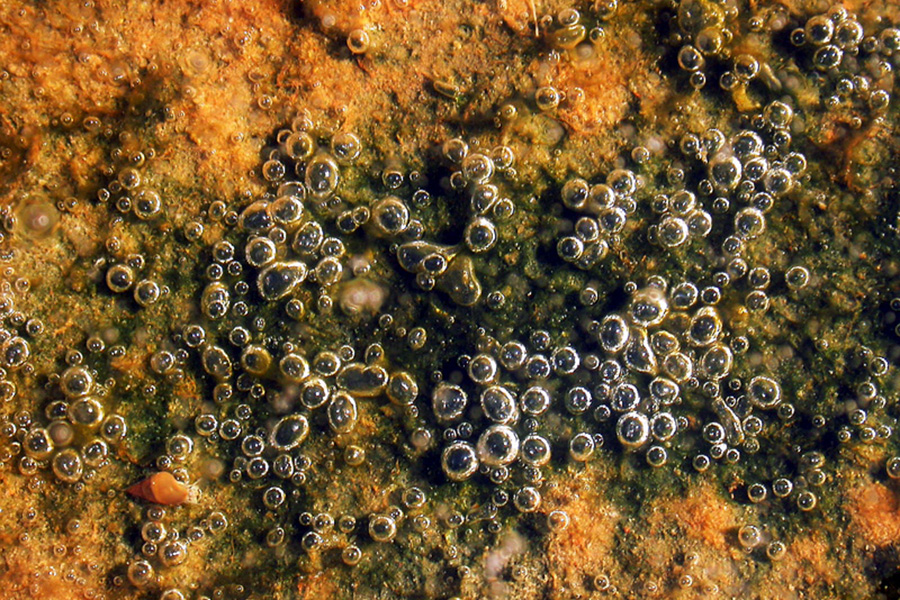Bioprecipitation of metallic copper from acid mine drainage in the Iberian Pyritic Belt
P20-01048 Plan Andaluz de Investigación, Desarrollo e Innovación (PAIDI 2020) // IP: Alfonso Corzo (96.000 €)
Project summary
Precipitates of Cu2+ and Cu+ salts and oxides are common in acid mine drainage (AMD) contaminated environments, but Cu0 precipitates are not. BIOCOBRE will investigate the biogeochemical conditions, microbial community and metabolic pathways involved in the precipitation of metallic copper (Cu0) nanoparticles in a biofilm growing in the acid mine drainage (AMD) of an abandoned mine (Huelva).
The objective of the project is to study precipitates of copper salts and oxides in environments contaminated by acid mine drainage (AMD). The biogeochemical conditions, the microbial community and the metabolic pathways involved in the precipitation of copper nanoparticles in biofilm growing in acid mine drainage (AMD) areas in the Faja Piritica Iberica (Huelva) will be investigated.
In order to understand the Cuº bioprecipitation process, we will establish the following objectives:
- define the geochemical environment within the biofilm where Cu0 precipitates and accurately measure Cu0 precipitation rates under different conditions,
- describe the evolution of the biofilm microbial community from colonization to maturity under different environmental conditions,
- isolate and culture the biofilm microorganisms (mainly fungi and bacteria) potentially involved in the Cu0 precipitation process.
To achieve these objectives, we will use a multidisciplinary approach combining state-of-the-art techniques from different scientific disciplines: microsensors (O2, H2S, pH and Eh), geochemical and mineralogical methods, scanning transmission electron microscopy (STEM), omics tools (metagenomics, metatranscriptomics, metaproteomics, metabolomics) and multispecific and axenic microbial cultures.
The scientific and socioeconomic impact of BIOCOBRE, if we are able to achieve Cu0 precipitation, could be high. It could lead to patents and would probably open a new line of research focused on the bioengineering of the Cu0 precipitation process, to make it a technically and economically viable alternative to recover Cu0 from AMD, using an ecological approach at a reduced cost, in which Andalucia would be at the forefront. These activities will be carried out by a multidisciplinary team, using advanced techniques.
Participants
National
Corzo Rodriguez, Alfonso, Dept Biología, Area de Ecología. Investigador principal, Coordinación general. Ecología microbiana
Papaspyrou, Sokratis, Dept Biología, Area de Ecología. Ecología microbiana.
García Robledo, Emilio Guillermo, Dept Biología, Area de Ecología. Ecología microbiana.
Duran Ruiz, Maria Del Carmen, Dept Biomedicina, Biotecnología y Salud Publica, Area de Bioquímica. Metaproteonómica.
Garrido Crespo, Carlos, Dept Biomedicina, Biotecnología y Salud Publica, Area de Microbiología. Aislamiento de microorganismos.
Lajaunie, Luc Cyrille Jacques, Dept de Ciencia de los Materiales e Ingeniería Metalúrgica y Química Inorgánica. Microscopia electrónica y análisis mineralógicos
Valverde Portal, Angel, IRNASA-CSIC. Microbiología.
International
Castillo Hernández, Julio Cesar. Univeridad de Free State, Sudafrica. Geomicrobiología, herramientas moleculares y microscopia.
Taylor, Joe Daniel, UK Centre for Ecology & Hydrology. Metagenómica.
Funding
The project (P20-01048) is co-financed by the European Union, within the framework of the Andalusia FEDER Operational Program “Smart growth: an economy based on knowledge and innovation, also responding to the Research and Innovation Strategy for the Smart Specialization of Andalusia (RISˑAndalusia) and the priorities and objectives set out in the Andalusian Plan for Research, Development and Innovation (PAIDI 2020).





